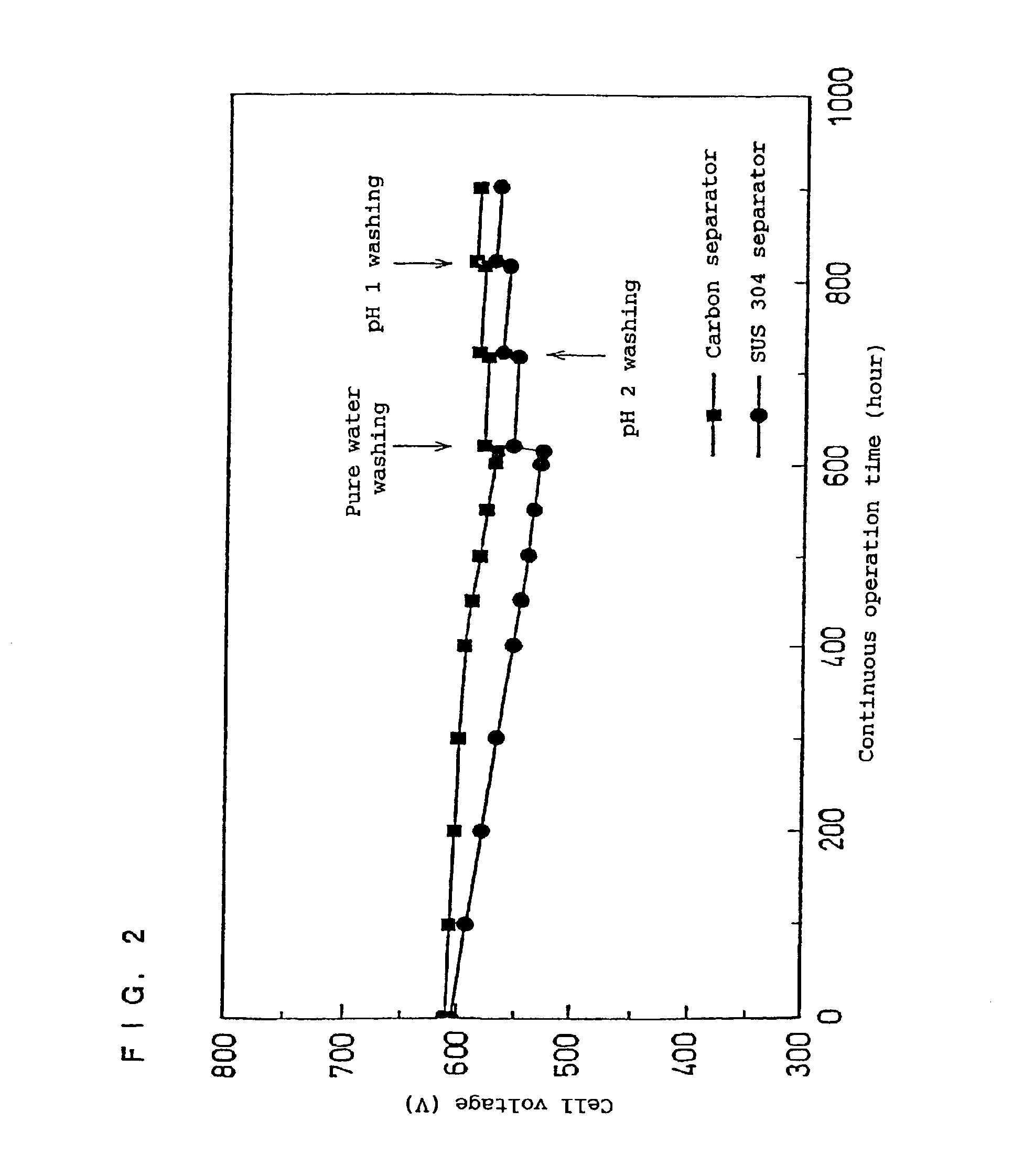Method for resorting characteristics of polymer electrolyte fuel cell
a technology of polymer electrolyte and fuel cells, applied in the field of restoring the performance of fuel cells, can solve the problems of fuel gas occasionally contaminated, insufficient emulsification, inability to elute, etc., and achieve the effect of restoring cell performan
- Summary
- Abstract
- Description
- Claims
- Application Information
AI Technical Summary
Benefits of technology
Problems solved by technology
Method used
Image
Examples
examples 1 and 2
[0030]An acetylene black carbon powder carrying 25 wt% of platinum particles having a mean particle size of approximately 30 Å was used as a catalyst for electrode. A dispersion in which a powder of this catalyst was dispersed in isopropanol was mixed with a dispersion in which a powder of perfluorocarbon sulfonic acid was dispersed in ethyl alcohol, thereby obtaining a paste for catalyst layer.
[0031]Meanwhile, a carbon paper having a thickness of 300 μm was immersed in an aqueous dispersion of polytetrafluoroethylene (PTFE), and dried to obtain a water-repellent gas diffusion layer (porous electrode base material). The above-described paste for catalyst layer was applied onto one surface of this gas diffusion layer, which was then dried to obtain an electrode comprising a catalyst layer and the gas diffusion layer.
[0032]Next, a polymer electrolyte membrane was sandwiched by a pair of the above electrodes, with the catalyst layers facing inwardly, and the whole was hot-pressed at a ...
examples 3 and 4
[0043]In the above Examples 1 and 2, it was confirmed that the object of the present invention could be achieved by changing the current density and thereby restoring the degraded performance of the fuel cell caused by the continuous operation.
[0044]In this example, a method for restoring the cell performance was conducted by increasing the loaded current to maintain the output voltage of each of fuel cells A and B, fabricated in the same manner as that used in Examples 1 and 2, at not more than 0.2 V for a predetermined time, and, thereafter, returning the operation to the normal mode.
[0045]As a result, it was also possible to restore the output voltage as described above by using this method.
examples 5 and 6
[0046]In the present examples, a method for restoring the dell performance was conducted by continuously operating each of fuel cells A and B, fabricated in the same manner as that used in Examples 1 and 2, for 500 hours, and reversing the direction of the output current after the cell voltage dropped.
[0047]More specifically, air was supplied to the anode side, to which hydrogen was supplied in the normal operation (output current=0.6 A / cm2), and hydrogen was supplied to the cathode side, to which air was supplied in the normal operation, and each cell was operated at 0.6 A / cm2 for 20 hours in this condition, with the direction of the output current being reversed. Thereafter, the operation was returned to the normal mode. By conducting such steps, the voltage of the fuel cell A using the carbon separator plate was restored, from 570 mV to 585 mV, and the voltage of the fuel cell B using the separator plate made of SUS 304 was restored, from 530 mV to 565 mV.
[0048]As described above...
PUM
| Property | Measurement | Unit |
|---|---|---|
| output voltage | aaaaa | aaaaa |
| thickness | aaaaa | aaaaa |
| thickness | aaaaa | aaaaa |
Abstract
Description
Claims
Application Information
 Login to View More
Login to View More - R&D
- Intellectual Property
- Life Sciences
- Materials
- Tech Scout
- Unparalleled Data Quality
- Higher Quality Content
- 60% Fewer Hallucinations
Browse by: Latest US Patents, China's latest patents, Technical Efficacy Thesaurus, Application Domain, Technology Topic, Popular Technical Reports.
© 2025 PatSnap. All rights reserved.Legal|Privacy policy|Modern Slavery Act Transparency Statement|Sitemap|About US| Contact US: help@patsnap.com



